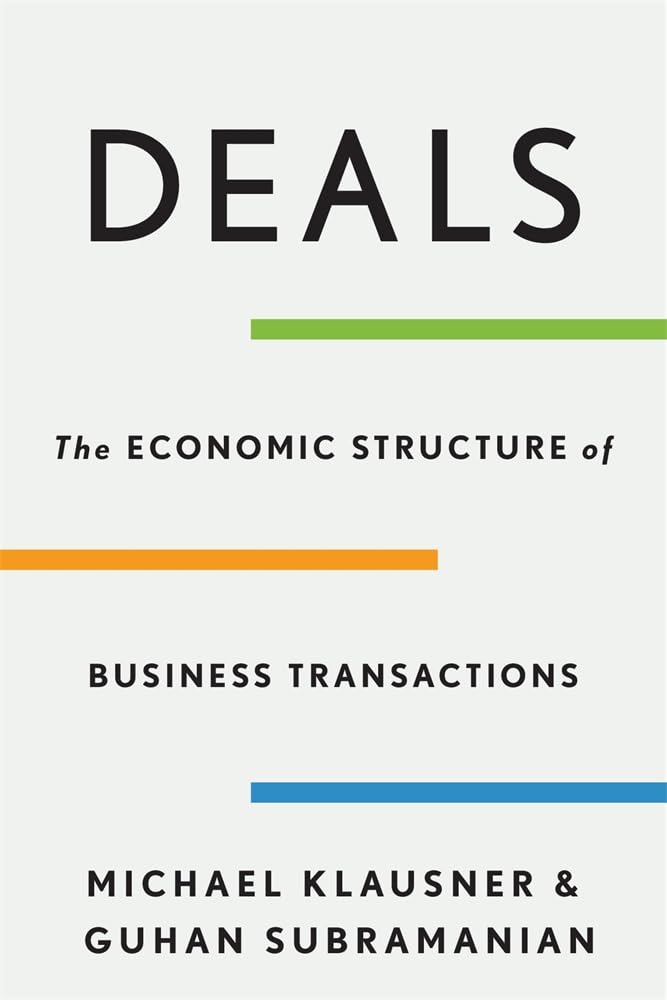Business contracts have gotten longer and more complicated over the last few decades, but it’s not because lawyers are padding them with “legalese” or fluff to justify their role, said Guhan Subramanian J.D./M.B.A. ’98, Harvard Law School’s Joseph H. Flom Professor of Law and Business.
“What’s really going on is lawyers and transactional planners and businesspeople are trying to solve some core economic problems” before the deal is sealed, said Subramanian, speaking at a Sep. 10 event hosted by the Program on Negotiation, which he chairs.
Subramanian’s talk drew from his recent book, “Deals: The Economic Structure of Business Transactions,” written with Michael Klausner of Stanford Law School. The work, Subramanian said, examines some of the biggest barriers that prevent negotiators from finding their “zone of possible agreement” — in other words, the range of terms on which all sides can agree — and how specific contractual elements can address those issues to get to a “yes.”
“We give [people] the building blocks from which they can be more effective as transactional planners,” he said of the book.


Referencing lessons gleaned from real-world negotiations, Subramanian outlined three major obstacles often faced by those negotiating business deals.
The first are distortions in behavior by one side that occur because of the deal itself, otherwise known as moral hazard. The classic example, Subramanian said, is someone who purchases fire insurance and stops worrying about replacing the batteries in their smoke detectors or begins leaving their iron on when they leave the house.
Subramanian said that he had encountered this problem when he worked on a deal involving the acquisition of Tiffany and Co. by luxury goods conglomerate LVMH.
Negotiations for the sale began in 2019, with the deal expected to close in 2020. But when the COVID pandemic hit, Tiffany closed its stores and sales plummeted, putting the deal in jeopardy. In addition to its concerns about Tiffany’s profitability, LVMH also balked at the jewelry company’s continued payments to shareholders while its peer companies had eliminated or reduced dividends to conserve cash. In other words, he said, LVMH was concerned that Tiffany was acting differently than it would if it were not being purchased.
Here, Subramanian continued, contractual covenants requiring a company to act “in the normal course of business” from signing to close could help — as could defining those terms very precisely. In other situations, lawyers include offers of “earn-outs” — or promises of future compensation for meeting specific financial goals after the deal is completed — to “smooth out … discontinuities” that incentivize undesirable behavior.
Next, Subramanian said that issues can arise when one party believes the other side has better information than they do about the transaction, which economists call adverse selection. He pointed to someone trying to sell their car as a prime example of a roadblock created by this informational asymmetry. Because they have been driving it, the seller knows a lot about the condition of their car, while the prospective buyer knows comparatively little.
“Here’s the problem,” he said. “The buyer will say to themselves and to you, ‘Why are you selling this car?’ The concern is that there is something wrong with this car … The very fact that you want to sell this car means I shouldn’t buy it.”
The seller could promise that nothing is wrong with the car, but a better solution would be to include guarantees in the sales contract itself, Subramanian said. “I’m going to give you representations about current facts, or a warranty about future facts. And these will be true, and if they’re not true, you can sue me later on.”
Finally, asset specificity — or the idea that some assets are less valuable outside the context of a specific deal, such as a product custom-made for one company — can pose problems for negotiation, Subramanian said. “The idea is that once you’ve invested in a certain direction, you can’t push the investment somewhere else.”
Here, he shared an example involving the NFL, which, in 2011, wanted to commemorate the anniversary of 9/11 by displaying football field-sized U.S. flags at 13 stadiums. The company it contracted with — which typically rents out these giant flags — did not own enough of them to fulfill the order. It was also hesitant to make more: The rental market wasn’t large enough to justify the extra units, it reasoned, and if it instead sold the flags to the NFL, the flag company would lose a major customer for future rentals.
Clever negotiators figured out a way around this dilemma, creating a structure akin to vertical integration, where a business involves itself in other aspects of its supply chain. In this case, the NFL gave a large upfront payment for the new flags and rental fees, with the flag company making payments back to the NFL later, when the flags were rented out to others. (And which the NFL agreed to help market and promote.)
“Vertical integration is a classic response to asset specificity,” said Subramanian. “I’m going to embed myself in your business, and we are going to work together to solve this problem.”
Of course, these solutions require more details in the final contracts, which Subramanian acknowledged during the Q&A portion of the event. He noted that in his 25 years of practice, the biggest change he had seen in his field was that agreements were becoming longer and more complex, and that the COVID pandemic was yet another impetus for this.
“Everyone went to their contracts to see what their force majeure clause said,” Subramanian continued, referring to a common condition that allows for cancellation of an agreement in the case of extreme and unexpected events such as a natural disaster or terrorist attack.
Before COVID, “those clauses were, like, two sentences,” and in many cases, it was not clear if a pandemic would count. Today, such clauses often stretch to two pages, Subramanian noted.
Now, companies are better prepared to weather future pandemics, he added, because lengthy contracts, while they may be intimidating, are often more comprehensive — solidifying the parties’ rights and responsibilities upfront and preventing unnecessary litigation.
“It’s for good business reasons,” he concluded. “If we work these things out in advance, we create value between the parties.”
Want to stay up to date with Harvard Law Today? Sign up for our weekly newsletter.
